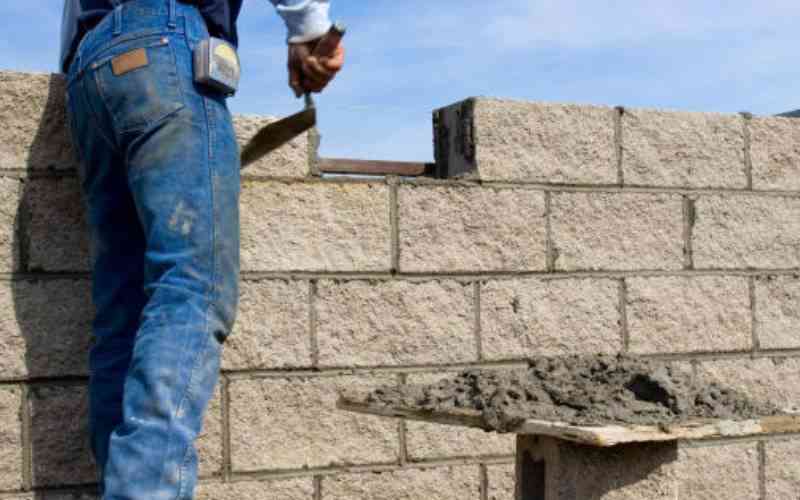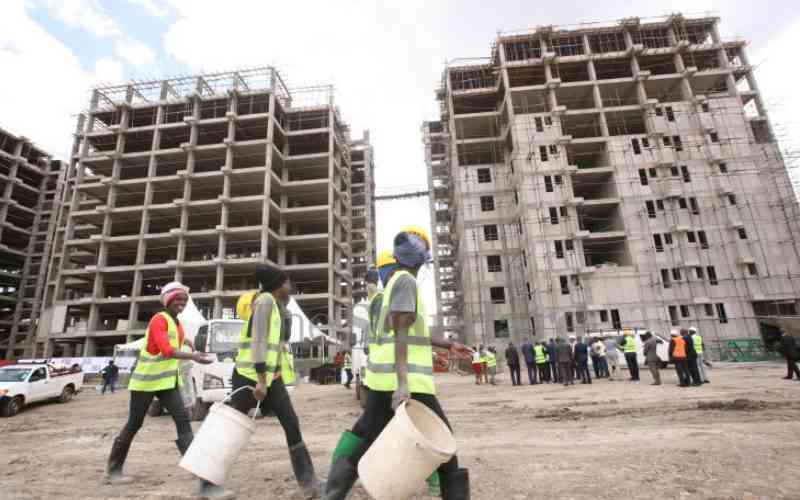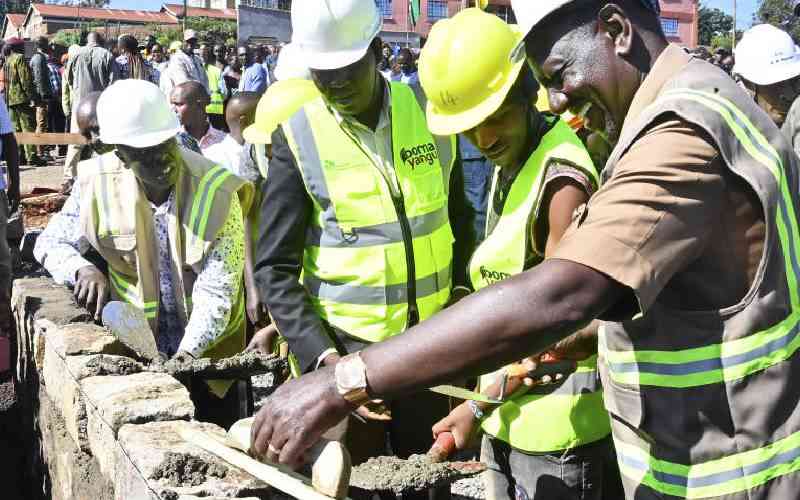By Peter Muiruri
Kenya: At independence, many Africans lived in mud-walled huts with grass-thatched roofs before shifting slowly to the British style stone houses.
It was not until the late 1960s when the Central government and the City Council spearheaded construction of low cost, single level structures in Eastlands such as Jerusalem and Jericho estates to house Africans, being drawn to the city by emerging employment opportunities.
City Council of Nairobi later spearheaded the construction of more estates including Uhuru and Harambee, aptly named after the then nationalistic fervor.
Rural investment
According to Dr Thiong’o Muchiri, an architect with close to 40 years experience and who once served as the assistant City Council of Nairobi physical planner, few Nairobi residents in the 1960s required permanent homes unlike the current situation where getting a slice of the city is a prime occupation to many Nairobians.
“Most people who came to Nairobi in the 1960s and 1970s viewed the young city as a place to make money, but invest in their rural areas. Few were willing to call Nairobi their home. In fact, those from Central Kenya could work and travel to their upcountry homes every weekend,” says Dr Muchiri.
Dr Muchiri says this trend contributed to the growth of Nairobi’s slums where structures were – and still are – of a temporary nature. “Contrary to popular belief, some of the people in the slums are not poor but do not consider Nairobi a permanent place of dwelling,” says Dr Muchiri.
However, as the country laid the foundation for future economic growth, so were groundbreaking ceremonies for some of Kenya’s iconic buildings.
A proposal by the then Kanu Secretary General Thomas Mboya to construct a building to house the independence party saw famed Kenyan architect David Mutiso draft the plans for Kenyatta International Conference Centre whose construction was completed in 1973.
Still, Kenyatta’s government was intent on providing decent housing to the masses, a mandate that the colonial government had taken up through an organisation that was formed in 1953 and forerunner to the National Housing Corporation.
According to Dr Muchiri, NHC capitalised on the fact that the City Council could no longer afford to house the mass of humanity that was migrating to the city at an alarming rate.
“The City Council was faced with liquidity problems and was always in debt while its priorities were also being directed to other areas of service delivery. There has been very little in the way of real estate developments by the City Council since Buruburu was constructed 30 years ago. In any case, there is no more land for construction in Nairobi,” he says.
The grim picture 50 years ago is a great contrast to the country’s current real estate. Kenya is slowly joining the league of the top real estate development destinations in the world. From the sandy beaches of the Indian Ocean to the slopes of Mount Kenya, projects worth billions of shillings are going up by the day.
Mega projects such as Tatu City, Thika Greens, Longonot Gate, English Point Marina and Sergoit to name just a few are promising to further transform the already vibrant real estate landscape.
Stay informed. Subscribe to our newsletter
According to the recently released 2013 Economic Survey, last year saw financial institutions lending over Sh69 billion to the industry, representing a 36.2 per cent increase over the previous year.
This funding resulted in the creation of employment opportunities as more than 10,000 individuals were assimilated in the sector.
“The value of building plans approved for Nairobi increased to Sh135 billion in 2012, an increase of 19.8 per cent over the previous year. The value of building plans for other towns also increased by 4.3 per cent,” says the survey.
Of the 16 cities sampled by Knight Frank’s Prime Global Rental Index covering the last quarter of last year, Nairobi recorded the highest rise in rentals amounting to 5.2 per cent for the months of September–December and an annual spike of 17.9 per cent for 2012.
Several factors have been attributed to the sharp rise in construction projects, key among them being the rapidly growing population in need of housing and a robust middle class whose purchasing power has lately improved.
Today, NHC, the main state organ mandated to provide affordable housing in Kenya has stepped up the construction of homes in various parts of the country, with several completed projects while others are in various stages of construction.
Private sector’s role
Last year, NHC embarked on a drive to construct 1,172 housing units in Nakuru, 48 in Likoni at the Coast, 52 bungalows in Kericho and 1,180 units in Kisumu.
The corporation’s notable projects in the capital city are currently under construction in Nairobi West while the units along the southern bypass are already occupied.
The last ten years, however, have seen the private sector become a big player in the provision of houses. According to professionals in the industry, the improved performance of the economy during the period enabled financial institutions to lend out funds to potential developers.
“The period between 2000 and 2010 was marked by a reduction of bank interest rates. This enabled Kenyans to easily obtain financing for construction. Towns such as Kitengela, Ongata Rongai and Ruai literally grew overnight. Residential estates for sale came up all over the country. New high-rise buildings came up around Nairobi’s CBD. Upper Hill, Westlands, Kilimani and Hurlingham grew overnight with numerous skyscrapers,” remarks Francis Gichuhi of A4Architects.
It is this growth that has catapulted the country into the big league of real estate developers as both local and foreign developers angling to get a slice of the big pie. Many Kenyans in the Diaspora have come out to invest in the sector with a view to attract capital gains.
Infrastructure
A key factor in the meteoric rise in the sector during this period is the government ambitious drive to improve infrastructure either through the rehabilitation of existing roads or construction of new ones.
As an example, property along the new Thika Superhighway and several bypasses has shot up tenfold since the completion of the roads.
Paradoxically, while Nairobi leads in terms of real estate development, it is also the place where millions have their homes in slums with their attendant problems. It is estimated that 85 per cent of city dwellers do not own the homes they live in thus escalating the rental prices.
The government is, however, trying to address this need through the slum upgrading project now underway in Kibera’s Soweto East where the first phase consisting of 900 housing units are under construction at a cost of Sh3 billion.
The project was launched in March last year by former President Mwai Kibaki as a joint venture between the Government of Kenya through the Ministry of Housing and the UN Habitat.
 The Standard Group Plc is a
multi-media organization with investments in media platforms spanning newspaper
print operations, television, radio broadcasting, digital and online services. The
Standard Group is recognized as a leading multi-media house in Kenya with a key
influence in matters of national and international interest.
The Standard Group Plc is a
multi-media organization with investments in media platforms spanning newspaper
print operations, television, radio broadcasting, digital and online services. The
Standard Group is recognized as a leading multi-media house in Kenya with a key
influence in matters of national and international interest.
 The Standard Group Plc is a
multi-media organization with investments in media platforms spanning newspaper
print operations, television, radio broadcasting, digital and online services. The
Standard Group is recognized as a leading multi-media house in Kenya with a key
influence in matters of national and international interest.
The Standard Group Plc is a
multi-media organization with investments in media platforms spanning newspaper
print operations, television, radio broadcasting, digital and online services. The
Standard Group is recognized as a leading multi-media house in Kenya with a key
influence in matters of national and international interest.









